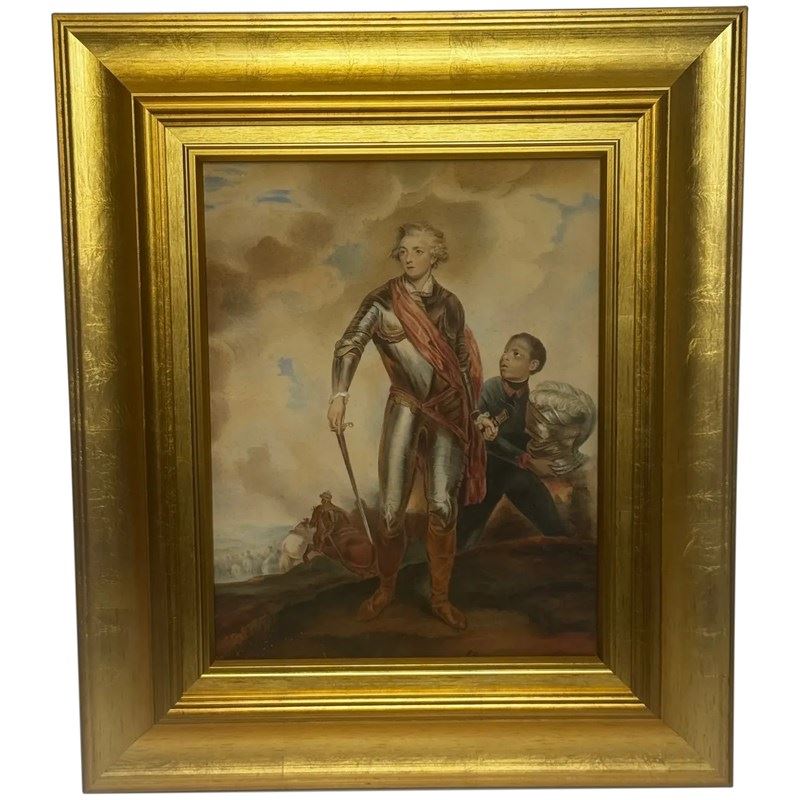Decorative Collective - www.decorativecollective.com
Sellers's Details
CHESHIRE ANTIQUES CONSULTANT LTD
Tel:
Email: [email protected]
https://www.decorativecollective.com/dealers/cheshire-antiques-consultant-ltdItem Details
Portrait of Power and Presence: Charles Stanhope with Marcus Richard Fitzroy Thomas, c. 1783
Executed in the Style of Sir Joshua Reynolds
Overview
This rare and evocative late 18th-century watercolour on paper presents Charles Stanhope, 3rd Earl of Harrington, clad in ceremonial armor, accompanied by Marcus Richard Fitzroy Thomas, a young Jamaican boy. Created around 1783 in the Grand Manner tradition, the work combines aristocratic grandeur with colonial reality — a visually powerful portrait layered with social and historical depth.
Style & Composition
Inspired by the dramatic compositions of Sir Joshua Reynolds, this piece is rich in allegorical tone and classical form. Stanhope stands center stage, resplendent in polished armor and a crimson sash, against a sky of swirling storm tones — indigo, ochre, and grey — symbolizing the political turbulence of the era.
Beside him stands Marcus Richard Fitzroy Thomas, rendered with striking realism and dignity. He holds the Earl’s helmet with solemn poise, dressed in dark livery. His grounded presence and thoughtful expression contrast Stanhope’s elevated posture, providing emotional balance and narrative weight.
The triangular composition leads the viewer from Marcus to Stanhope to the turbulent sky — a metaphor for power, race, and visibility in the age of empire. Stanhope is mythologized; Marcus is humanized. Together, they tell a complex, unequal, but unforgettable story.
Historical Context
Charles Stanhope (1753–1829) served in Jamaica — Britain’s most fortified and profitable slave colony — during the final stages of the American Revolutionary War. Promoted to Colonel in 1782 and appointed Aide-de-Camp to King George III, he later inherited the title of Earl and married Jane Fleming, whose wealth stemmed from Caribbean plantations.
Marcus Richard Fitzroy Thomas, estimated to be 14 at the time, was likely brought from Jamaica as part of Stanhope’s retinue. Later records reveal an extraordinary life: baptized in London (on the same day as Stanhope’s child), Marcus joined the Westminster militia as a drummer, married, had children, and died in poverty in 1816. He is buried in St. Martin’s Gardens, Camden — a named Black subject whose story resists historical erasure.
Attribution
Though unsigned, the work bears all the hallmarks of Sir Joshua Reynolds — first President of the Royal Academy and pioneer of the Grand Manner portrait. The dramatic setting, allegorical sky, and heroic posture echo his style, while the frank and human portrayal of Marcus introduces a rare tension, subtly challenging the genre’s typical glorification.
Frame & Presentation
Framed in a finely crafted reverse-profile gold leaf moulding, the artwork has been professionally conserved and reglazed with AR70 museum glass — offering UV protection and dramatically reduced glare, preserving both the delicacy and impact of the watercolour medium.
Framed Dimensions: 55 cm (H) × 47 cm (W)
Depth: 1.5 cm
📚 Provenance
Private Scottish Collection
Acquired via respected Scottish auction
Curated by Cheshire Antiques Consultant LTD
Exhibited at a regional museum in the English Midlands
Key Features
✅ A rare Grand Manner watercolour with layered historical and cultural narrative
✅ Features a named Black subject — exceptionally rare in 18th-century British portraiture
✅ Richly evocative of themes including race, empire, identity, and representation
✅ Conservation-framed with premium AR70 museum glass for optimal display
✅ Ideal for serious collectors, institutions, or those passionate about overlooked histories
Condition
Overall good antique condition. The paper remains stable with vivid pigment. Minor foxing, gentle fading, and background touch-ups are visible upon close inspection. Some paint loss is present in the lower corner. The handmade frame is clean, solid, and ready to hang.
Shipping
Worldwide delivery available. Expertly packed and fully insured for safe global transit.
- Period: 18th century
-
- Price: £5,000.00
- €5,699 Euro
- $6,692 US Dollar
- Location: London
-
- Dimensions: H: 55cm (21.65in)
- W: 47cm (18.50in)
- D: 1.5cm (0.59in)
